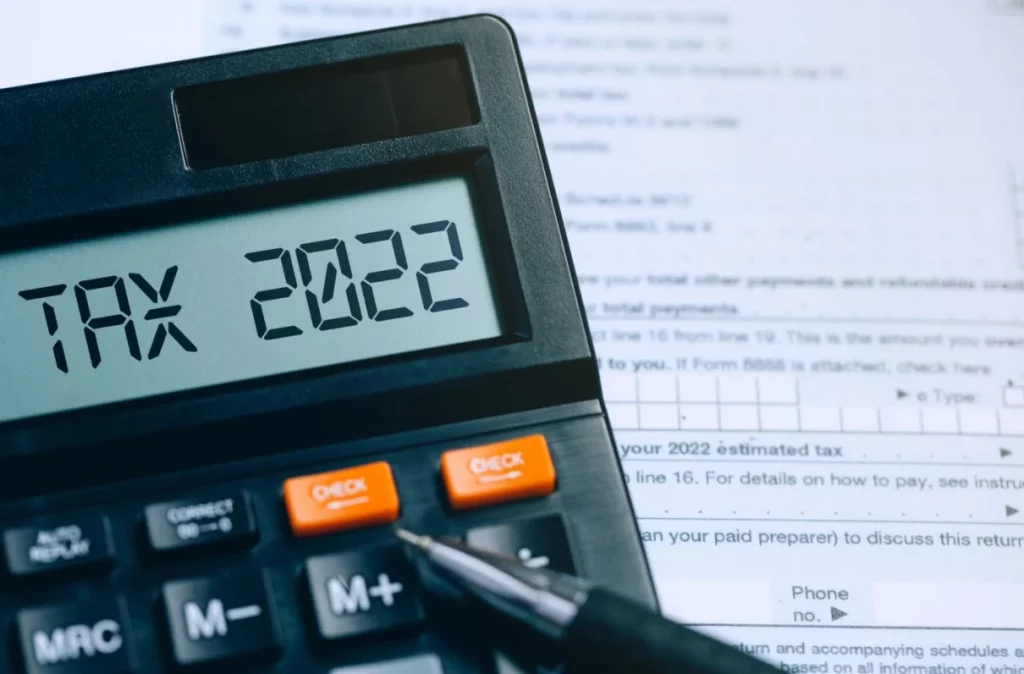Changes That May Affect Your 2022 Tax Return

When it comes to taxes, one might call 2022 the year of the great reset. That’s because a lot of things that were put into place for 2021 will revert back to pre-pandemic years, which could lead to refund shock or, more importantly, balance-due shock.
In addition, some new regulations were put into place. Third-party payment apps like PayPal, CashApp and Venmo will now be reporting money earned by freelancers throughout the year to the IRS. Student loan forgiveness — if passed — is exempt from federal taxation, but borrowers in some states may owe taxes. And lastly, if you had any crypto activity in the past year, the IRS wants to know about it.
Here are the most significant tax changes as you prepare for this upcoming tax season.
1. The standard deduction for 2022 is higher.
It’s typical for the standard deduction to increase a little each year, along with the rate of inflation. Below is a table which shows the standard deduction for the 2021 through 2023 tax years:
| Filing status | 2021 TY | 2022 TY (1) | 2023 TY |
| Single | $12,550 | $12,950 | $13,850 |
| Married, filing jointly | $25,100 | $25,900 | $27,700 |
| Married, filing separately | $12,550 | $12,950 | $13,850 |
| Head of household | $18,800 | $19,400 | $20,800 |
(1) For the 2022 tax year, you get to add an additional $1,400 to your standard deduction if you’re over 65 or blind; if you’re also unmarried and not a surviving spouse, that jumps up to $1,750.
2. Income tax brackets are also higher in 2022
When it comes to federal income tax rates and brackets, the tax rates themselves didn’t change from 2021 to 2022. There are still seven tax rates in effect for the 2022 tax year. However, as they are every year, the 2022 tax brackets were adjusted to account for inflation. That means you could wind up in a different tax bracket when you file your 2022 federal income tax return than the bracket you were in before – which means you could pay a different tax rate on some of your income.
2022 tax brackets for single filers and married couples, filing jointly
| Tax Rate | Taxable income (Single) | Taxable income (Married, filing jointly) |
| 10% | Up to $10,275 | Up to $20,550 |
| 12% | $10,276 – $41,775 | $20,551 – $83,550 |
| 22% | $41,776 – $89,075 | $83,551 – $178,150 |
| 24% | $89,076 – $170,050 | $178,151 – $340,100 |
| 32% | $170,051 – $215,950 | $340,101 – $431,900 |
| 35% | $215,951 – 539,900 | $431,901 – $647,850 |
| 37% | Over $539,900 | Over $647,850 |
2022 tax brackets for married couples, filing separately and HOH filers
| Tax Rate | Taxable income (Married, filing separately) | Taxable income (Head of household) |
| 10% | Up to $10,275 | Up to $14,650 |
| 12% | $10,276 – $41,775 | $14,651 – $55,900 |
| 22% | $41,776 – $89,075 | $55,901 – $89,050 |
| 24% | $89,076 – $170,050 | $89,051 – $170,050 |
| 32% | $170,051 – $215,950 | $170,051 – $215,950 |
| 35% | $215,951 – $323,925 | $250,951 – $539,900 |
| 37% | Over $323,925 | Over $539,900 |
3. Retirement contributions limits increased
For the 2022 tax year, the individual 401(k) limit increased to $20,500, a $1,000 increase from 2021. If you’re over 50, you can contribute an additional $6,500. The total contribution limit, which includes your employer’s contributions, is $61,000 for 2022 ($67,500 for those 50 or older). IRA contributions remain unchanged at $6,000 for the year, with a $1,000 additional catch-up contribution for those 50 or older. Contributions to SIMPLE IRAs were also increased in 2022, from $13,500 to $14,000. Those over 50 can contribute an additional $3,000.
If you are self-employed, consider investing in a Simplified Employee Pension (SEP). You can contribute as much as 25% of your net earnings from self-employment, up to $61,000.
If you have an IRA, you can continue contributing for tax year 2022 until April 18, 2023, this year’s tax filing deadline.
4. The child tax credit has returned to normal
While 2021 had a temporary expansion of the child tax credit, including eligibility for more dependent children and offering advance payments, this isn’t the case for your 2022 taxes.
The CTC has dropped back down to its pre-pandemic amount — $2,000 per child or dependent – and is now only available for children under 17 years of age. The credit, which was fully refundable last year, is now only partially refundable to some lower-income parents, and advance payments are no longer in effect. (Partially refundable means you can only receive a portion of this credit as a refund, though the full amount can be applied to your tax bill.)
That said, you should still claim the CTC in 2022, if eligible. The credit is available if you earn up to $200,000 as a single taxpayer or head of household (or up to $400,000 if you are a married couple filing jointly). It can help boost your refund or may help offset a tax bill. And, while federal benefits have decreased, some states are offering child tax credit benefits this year and next.
5. Fewer filers will qualify for the Child Care and Dependent Tax Credit
For the 2022 tax year, the Child and Dependent Care Credit adjusts back to the pre-2021 provision. Now, parents with one child under 13, an incapacitated spouse or parent, or another dependent so you could work or look for work can only claim up to 35% of a maximum of $3,000 in qualify expenses, for a maximum amount of $1,050. Parents with more than one child are eligible for up to 35% of up to $6,000 in qualifying expenses, for a maximum amount of $2,100.
The biggest difference is the income qualification. To receive this credit in full in 2022, you must have made $15,000 or less – a steep drop from 2021’s $125,000 income threshold – – though households earning up to $438,000 are eligible to receive at least partial credit.
6. If you don’t have kids, it’s harder to qualify for the Earned Income Tax credit this year
Last year, more Americans were eligible to claim the Earned Income Tax Credit (EITC) on their 2021 tax returns. This year, the EITC jumps back to pre-pandemic levels.
For your 2022 tax returns, the maximum you can claim for EITC if you do not have kids or dependents is $560, a $942 decrease from last year’s maximum of $1,502. The age requirements have also shifted back to the original rules – you must be between 25 and 65 to qualify.
Note, the income requirements for the EITC and maximum credits for those with children have increased slightly due to inflation.
7. If your student loans were forgiven, you may owe state taxes
Though widespread federal student loan relief remains on hold, you may have received student loan forgiveness through the Public Service Loan Forgiveness program or another similar endeavor. If you had any balances forgiven in 2022, you won’t owe federal taxes on the canceled amount. That’s because of a provision in the 2021 American Rescue Plan, preventing forgiven post-secondary education loans from federal taxation through 2025.
However, there are a handful of states where forgiven loan balances may be taxed. Indiana, Minnesota, Mississippi and North Carolina have confirmed that they will tax any student loan debt relief on your 2022 taxes. A few other states may as well, though details are still being hammered out.
8. You have to report your crypto and NFT transactions
While not technically new, for 2022 the IRS is making a more concerted effort to track cryptocurrency sales and trades. Whenever you sell or trade your crypto or purchase an item with crypto, you trigger a taxable event. Currently, crypto is taxed like property, making it subject to short- or long-term capital gains taxes. This also means you can report and crypto losses to help offset any gains. Since 2022 saw a drastic drop in the value of cryptocurrencies like bitcoin and Ethereum, if you sold or traded your crypto at a loss, you may be able to reduce your tax bill by reporting your capital loss. The same goes for NFTs.
And though the IRS will flag any unreported crypto gains, if you don’t report a loss that can lower your tax burden, the IRS won’t adjust your return on your behalf. If you are unsure of the tax implications concerning crypto and NFT transactions, you should seek out guidance from a trained experience tax professional.
9. PayPal, Venmo and other third-party apps will report your payments to the IRS
If you’ve been self-employed or freelancing for a few years, you likely already know that you’re required to report your freelance earnings to the IRS. This year, your earnings will be even easier for the IRS to access, since third-party apps are now reporting your payment activity to the IRS.
Platforms like PayPal, Venmo, Cash App, Zelle and others will be providing users with 1099-K forms, which can make reporting your income a little easier. Note that only earnings sent through these third-party apps are subject to taxation.
10. Temporary charitable donation deductions have ended
The expanded charitable contribution benefits that were offered in 2020 and 2021 have ended. The benefit that allowed taxpayers claiming the standard deduction an “above the line” deduction of up to $300 ($600 for married, joint filers) in charitable contributions is no longer available. In addition, the allowance for cash contributions up to 100% of AGI (adjusted gross income) expired. Cash contributions between 2022 and 2025 is limited to 60% of AGI. Cash contributions after 2025 will be limited to 50% of AGI.
DISCLAIMER: This information contained in this blog post came from different news sources and is intended for information purposes only. Consult with your financial advisor or accountant to see how these changes may impact your taxes. Sources: Avoid Refund Shock: How These 10 Changes May Affect Your Tax Return – CNET; IRS provides tax inflation adjustments for tax year 2022 | Internal Revenue Service;

